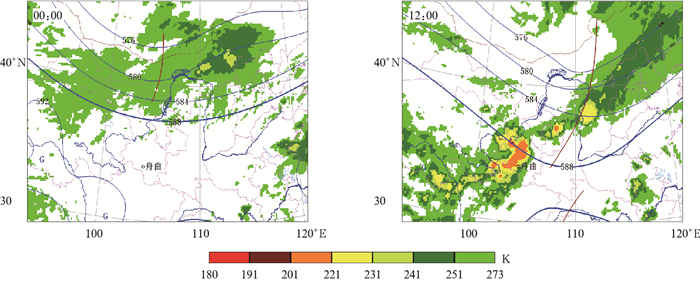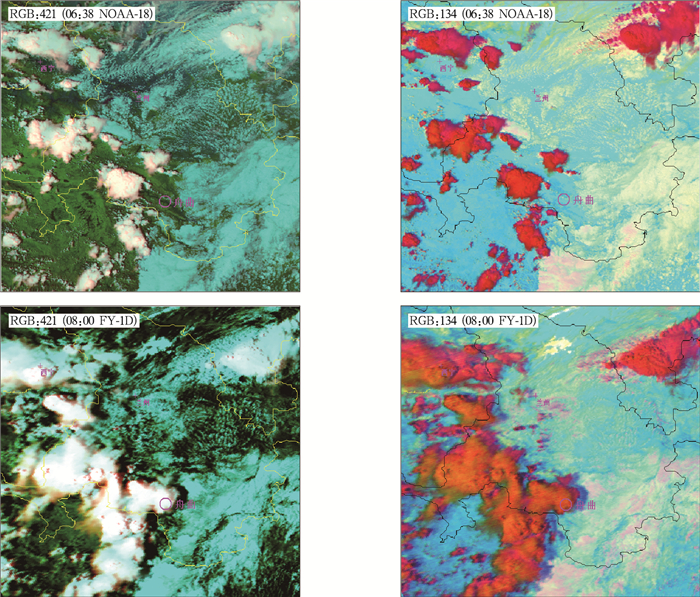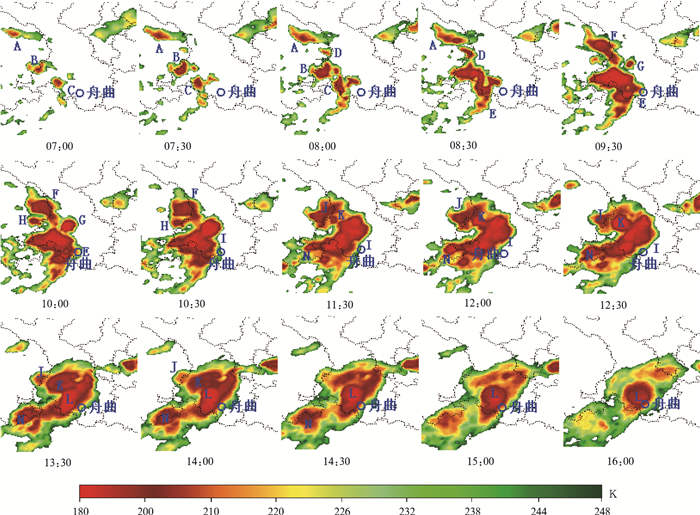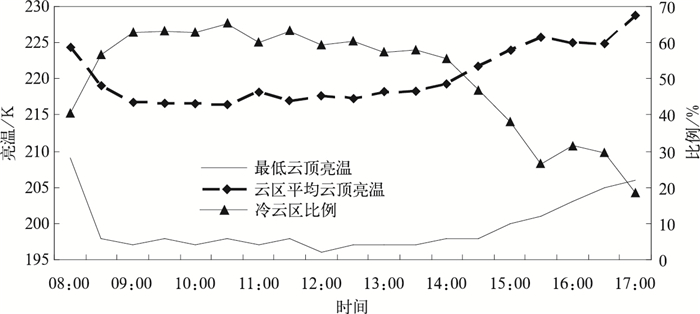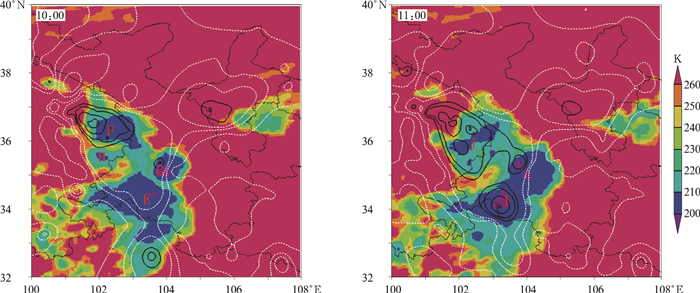Cumulus Merging in the Massive Mudslide of Zhouqu Using Meteorological Satellite Data
-
摘要: 利用极轨和静止气象卫星红外云图资料,对2010年8月7日甘肃舟曲发生的特大泥石流天气过程中出现的对流云合并现象进行分析。从卫星监测结果来看,多个对流单体合并而成的中尺度对流系统,在发展过程中产生了局地强降水,从而引发了特大泥石流灾害。整个过程中有5个阶段出现了合并现象:首先,多个对流单体合并形成中尺度对流系统; 在中尺度对流系统的发展和维持过程中,3个阶段出现了新旧对流系统的合并; 在系统即将消散的阶段又出现了两个强中心的合并。合并过程不仅促成中尺度对流系统的生成,使得云体增强发展,而且为对流系统维持补充了能量,使系统生命史延长。另外,在5个阶段的合并过程中,合并机制可以归结为内部动力结构变化和外致碰撞合并两大类。其中,在系统形成阶段,外致碰撞合并是主要机制; 而在发展维持阶段,包括气压梯度力、辐合抬升、下沉-上升环流加强等在内的内部动力结构变化影响是发生合并的主要原因。Abstract: Heavy rainfall occurs abruptly at Zhouqu, Gansu Province from 7 August to 8 August of 2010, causing massive mudslide and brings about huge casualties. As an observational fact, it is clear that a meso-scale convective system, which is produced by several convective cells merging, brings heavy rain in local field and the massive mudslide at Zhouqu. The phenomenon of cumulus merging is analyzed using meteorological satellite data, such as FY-2D/E, NOAA-18 and FY-1D, to find out its impact on heavy rain.As NOAA-18 satellite image shows, there are several cells around the Zhouqu at 0638 UTC 7 August 2010. One and half hours later, cells are merged and forms a meso-scale system. And the meso-scale system is still developing in FY-1D satellite image.From FY-2D/E satellite images, there are five stages of cumulus merging in the whole process. First, the meso-scale convective system comes out due to the merging of multi-cells from 0700 UTC to 0800 UTC. And it is the developing and maintaining period of meso-scale convective system. The cumulus merges in 3 stages. First, a developing system merges with several nearby new generation cells at about 0930 UTC. Then a systems merges between a mature new generation system and the old convective system from 1000 UTC to 1030 UTC, the new and old systems merge from 1130 UTC to 1200 UTC. Finally, two centers of cloud with cold cloud top temperature are merged as the dissipating of convective system after 1300 UTC. As the centers have been merged, the system develops again and the cold cloud areas have increased.As a result of the merging effect, not only a large and complex convective system is produced and becomes more intensity, but also the lifetime of convective system is greatly enhanced with more convective energy.On the other hand, the mechanisms of merging in five stages could be classified as change of inner dynamical structure and collision with outer force. At the building stage of meso-scale convective system, collision with outer force is the main cause of cumulus merging. But with the development and maintain of system, inner changes of dynamical structure, such as pressure gradient force, convergence and up-down circumfluence, are the primary mechanisms for merging.
-
Key words:
- satellite image;
- meso-scale convective system;
- cumulus merging
-
图 1 2010年8月7日00:00和12:00背景场 (a)00:00 500 hPa高度场 (实线,单位:dagpm) 和温度场 (虚线, 单位:℃),(b)12:00 500 hPa高度场 (实线,单位:dagpm) 和温度场 (虚线, 单位:℃),(c)00:00 700 hPa风场 (单曲线表示槽线;箭头表示西南气流),(d)12:00 700 hPa风场 (单曲线表示槽线;双曲线表示切变线)
Fig. 1 Synoptic chart at 0000 UTC and 1200 UTC on 7 Aug 2010 (a)500 hPa height (solid line, unit:dagpm) and temperature (dashed line, unit:℃) at 0000 UTC, (b)500 hPa height (solid line, unit: dagpm) and temperature (dashed line, unit:℃) at 1200 UTC, (c)700 hPa wind at 0000 UTC (single curve:trough; arrow:southwestern airflow), (d)700 hPa wind at 1200 UTC (single curve:trough; double curves:shear line)
-
[1] 付丹红, 郭学良.积云合并在强对流系统形成中的作用.大气科学, 2007, 31(4):635-644. http://www.cnki.com.cn/Article/CJFDTOTAL-DQXK200704007.htm [2] 甄长忠. 78810冰雹过程的分析.大气科学, 1981, 5(4):456-460. http://www.cnki.com.cn/Article/CJFDTOTAL-DQXK198104012.htm [3] 王昂生, 赵小宁, 康玉霞, 等.昔阳地区冰雹云形成过程的一些特征.大气科学, 1980, 4(2):456-460. http://www.cnki.com.cn/Article/CJFDTOTAL-DQXK198002009.htm [4] 顾亚进, 党人庆, 唐洵昌, 等.一次MCS过程的卫星云图和数值模拟分析.气象科学, 2002, 22(2):197-204. http://www.cnki.com.cn/Article/CJFDTOTAL-QXKX200202008.htm [5] 杨金锡, 陈晓红, 王东勇.1991年7月6—7日黄山特大暴雨分析.气象, 1993, 19(1):39-42. doi: 10.7519/j.issn.1000-0526.1993.01.009 [6] 王瑾, 蒋建莹, 江吉喜."7·18"济南突发性大暴雨特征.应用气象学报, 2009, 20(3):295-302. doi: 10.11898/1001-7313.20090305 [7] 李艳伟, 牛生杰, 姚展予, 等.云合并的初始位置探讨.大气科学, 2009, 33(5):1015-1026. http://cdmd.cnki.com.cn/Article/CDMD-10141-1016033574.htm [8] 胡雯, 黄勇, 汪腊宝.夏季江淮区域对流云合并的基本特征及影响.高原气象, 2010, 29(1):206-213. http://www.cnki.com.cn/Article/CJFDTOTAL-GYQX201001024.htm [9] 黄美元, 徐华英, 吉武胜.积云合并及相互影响的数值模拟研究.中国科学:B辑, 1987, 17(2):214-224. http://www.cnki.com.cn/Article/CJFDTOTAL-JBXK198702012.htm [10] 曲晓波, 张涛, 刘鑫华, 等.舟曲"8.8"特大山洪泥石流灾害气象成因分析.气象, 2010, 36(10):102-105. doi: 10.7519/j.issn.1000-0526.2010.10.017 [11] 钤伟妙, 罗亚丽, 张人禾, 等.引发舟曲特大泥石流灾害强降雨过程成因.应用气象学报, 2011, 22(4):385-397. doi: 10.11898/1001-7313.20110401 [12] 郑永光, 陈炯, 朱佩君.改进的静止卫星云图软件处理系统.气象, 2007, 33(12):103-109. doi: 10.7519/j.issn.1000-0526.2007.12.016 [13] 金明星, 张长江.台风云图伪彩色增强的Berkeley小波变换法.计算机应用, 2010, 30(6):1602-1605. http://www.cnki.com.cn/Article/CJFDTOTAL-JSJY201006050.htm [14] 李修芳, 范蕙君, 燕芳杰, 等.用增强显示云图确定热带气旋强度的方法.应用气象学报, 1993, 4(3):362-369. http://qikan.camscma.cn/jams/ch/reader/view_abstract.aspx?file_no=19930361&flag=1 [15] 费增坪, 王洪庆, 张焱, 等.基于静止卫星红外云图的MCS自动识别与追踪.应用气象学报, 2011, 22(4):115-122. http://qikan.camscma.cn/jams/ch/reader/view_abstract.aspx?file_no=20110112&flag=1 [16] Morel C, Senesi S.A climatology of mesoscale con-vective systems over Europe using satellite infrared imagery. Ⅰ: Methodology. Q J R Meteorol Soc, 2002, 128:1953-1971. doi: 10.1256/003590002320603485 [17] 周著华, 白洁, 刘健文, 等, MODIS多光谱云相态识别技术的应用研究.应用气象学报, 2005, 16(5):678-684. doi: 10.11898/1001-7313.20050515 [18] 周著华, 白洁, 刘健文, 等.基于EOS/MODIS的台风"浣熊"云顶相态分析.气象科学, 2006, 26(5):494-501. http://www.cnki.com.cn/Article/CJFDTOTAL-QXKX200605003.htm [19] Smith R B, Evans J P. Orographic Precipitation and Water Vapor Fractionation over the Southern Andes. J Hydrometeorology, 2007, 8:3-18. doi: 10.1175/JHM555.1 [20] Lensky I M, Rosenfeld D. Clouds-aerosols-precipitation satel-lite analysis tool (CAPSAT). Atmos Chem Phys Discuss, 2008, 8(24):6739-6753. http://www.oalib.com/paper/2706409#.WRA4nPl6-0I [21] 陈英英, 唐仁茂, 周毓荃, 等.用三通道合成彩色图像进行云的分类解释判读.应用气象学报, 2011, 22(6):691-697. doi: 10.11898/1001-7313.20110606 [22] Orville H D, Kuo Y H, Farley R D, et al. Numerical simulation of cloud interactions. J Rech Atmos, 1980, 14:499-516. http://adsabs.harvard.edu/abs/2009AGUFM.A13J0426A [23] Takahashi T, Yamaguchi N, Kawano T. Videosonde observation of torrential rain during Baiu season. J Meteor Soc Japan, 2001, 58(3):205-228. http://www.sciencedirect.com/science/article/pii/S0169809501000837 -


 设为首页
设为首页 加入收藏
加入收藏



 下载:
下载:
